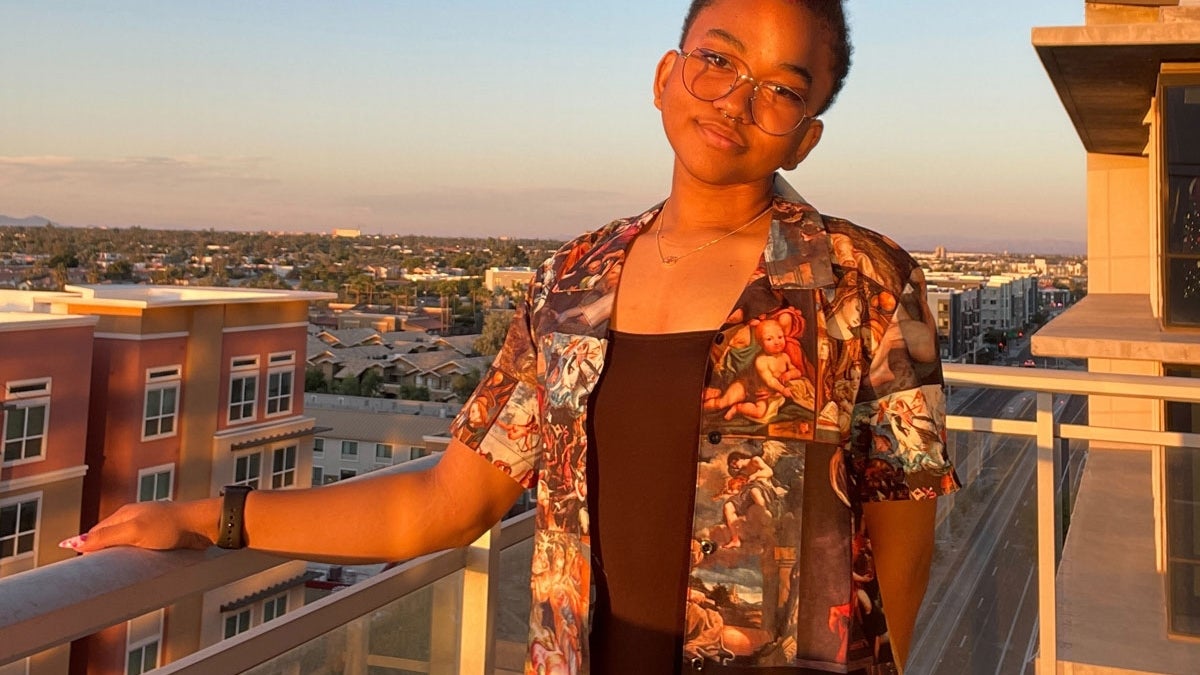ASU grad finds their identity in informatics and digital culture

Arizona State University informatics and digital culture graduate Elizabeth Harris came to the university to make a big change, and ended up finding that and more through their major, the communities they joined and in helping others.
Editor's note: This story is part of a series of profiles of notable fall 2021 graduates.
When Elizabeth Harris made the 18-hour drive for the first time to attend Arizona State University, they were unsure of themself, but sure of wanting to make a big change.
“I went from a graduating class of 181 to a university with more than 70,000 people,” says Harris, who uses gender-neutral pronouns. “Coming to ASU helped me to find myself, separate from the things I’d held onto as an identity for the previous 17 years of my life.”
Harris found a new identity in part through the informatics major in the Ira A. Fulton Schools of Engineering at ASU and a certificate in digital culture from the Herberger Institute for Design and the Arts.
“It felt as though everything I was learning was second nature, just stored in a part of my brain that I didn’t know was there,” Harris says. “The opportunity to have a digital culture concentration and truly be at the crossroads between art, technology and humanity opened my eyes to so many career paths.”
Harris enjoyed the community of eager new students and the many learning opportunities at Tooker House, the Fulton Schools residential community. In their first year, Harris also played the role of ASU mascot Sparky for the Downtown Phoenix campus and appeared as themself on the jumbotron at football games.
Through informatics, Harris discovered that failure was fun and fixing bugs was like solving an escape room. And by participating in hackathons — even winning a second-place prize in an Action.ML hackathon — Harris had the opportunity to solve challenges and determine their niche in the field of informatics.
Harris also helped others through work as a grader and undergraduate teaching assistant. They found being a teaching assistant rewarding as they could guide students to the right answers and provide a sense of pride and accomplishment.
This opportunity came from one of Harris’ most impactful professors, Principal Lecturer Farideh Tadayon-Navabi. Through Tadayon-Navabi’s classes, Harris transformed from feeling terrified to learn to code to confidently teaching concepts to others.
The experience also contributed to Harris securing an internship at IBM and earning two Grace Hopper scholarships.
Throughout the last three-and-a-half years, Harris has gained the confidence to make space for themself in the diversifying field of engineering, where “it’s important to listen to all the voices in the room.”
After graduation, Harris will begin a junior associate project manager position with digital consulting company Publicis Sapient in Denver. Long term, Harris wants to work in artificial intelligence.
“With the birth of a new field, it’s important to have diversity in its creation,” Harris says. “Things like darker skin tones and disabilities are often forgotten with large-scale projects, and there needs to be a voice for them within the development room. I want to be in the room where it happens.”
More Science and technology

Lucy's lasting legacy: Donald Johanson reflects on the discovery of a lifetime
Fifty years ago, in the dusty hills of Hadar, Ethiopia, a young paleoanthropologist, Donald Johanson, discovered what would…

ASU and Deca Technologies selected to lead $100M SHIELD USA project to strengthen U.S. semiconductor packaging capabilities
The National Institute of Standards and Technology — part of the U.S. Department of Commerce — announced today that it plans to…

From food crops to cancer clinics: Lessons in extermination resistance
Just as crop-devouring insects evolve to resist pesticides, cancer cells can increase their lethality by developing resistance to…